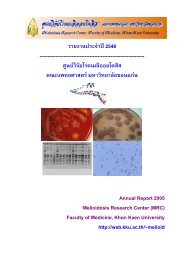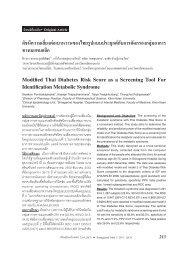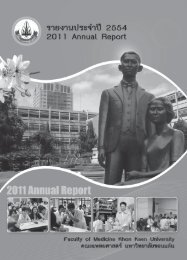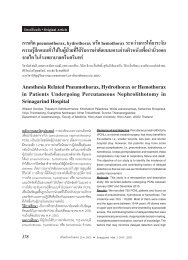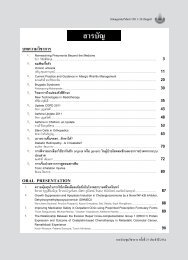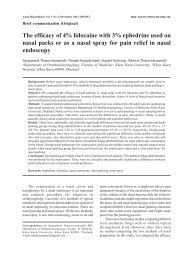Radiation dose from CT scanning: can it be reduced?
Radiation dose from CT scanning: can it be reduced?
Radiation dose from CT scanning: can it be reduced?
You also want an ePaper? Increase the reach of your titles
YUMPU automatically turns print PDFs into web optimized ePapers that Google loves.
Vol. 5 No. 1February 2011<strong>Radiation</strong> <strong>dose</strong> <strong>from</strong> <strong>CT</strong> <strong>s<strong>can</strong>ning</strong>15Data <strong>from</strong> survivors of atomic bombing inHiroshima and Nagasaki [13, 14] were used to createa risk model. <strong>Radiation</strong> <strong>dose</strong>s <strong>from</strong> <strong>CT</strong> are usuallylower than the <strong>dose</strong> to those survivors, but this mightnot <strong>be</strong> true when multiple <strong>CT</strong> s<strong>can</strong>s have <strong>be</strong>enperformed. Many reviews in the l<strong>it</strong>erature have datarelating <strong>can</strong>cer risk to patients receiving diagnosticradiation [15-19]. These relate to breast <strong>can</strong>cer andfluoroscopy of the chest in tu<strong>be</strong>rculosis patients, tofrequent radiographs of the spine in scoliosis patients,to <strong>can</strong>cer of salivary glands and thyroid gland andimaging of the head and neck region, and to leukemiarelated to frequent radiation exposure in children.Linear extrapolation and linear quadratic extrapolationare proposed to predict the solid <strong>can</strong>cer and leukemiaincidence for lower radiation <strong>dose</strong>s [20].<strong>CT</strong> s<strong>can</strong>s have <strong>be</strong>come the major source ofhuman exposure to diagnostic X-rays as they representthe highest share of collective <strong>dose</strong>s <strong>from</strong> medicalexposures. This is the reason why there is nowconcern about the increasing use of <strong>CT</strong>, particularlyin pediatric patients whose tissues are more prone toradiation effects (Fig. 1) [21]. <strong>CT</strong> in children should<strong>be</strong> performed only when the <strong>be</strong>nef<strong>it</strong> is clearly abovethe risk. It must <strong>be</strong> performed only to the arearequired, w<strong>it</strong>h lim<strong>it</strong>ed phases of <strong>s<strong>can</strong>ning</strong>, and w<strong>it</strong>hthe lowest radiation that still gives diagnostic imagequal<strong>it</strong>y. There is also a higher risk of <strong>can</strong>cer in femalesthan in males. This <strong>can</strong> <strong>be</strong> explained by smaller femalesize and different pos<strong>it</strong>ion of radiosens<strong>it</strong>ive organs [23].In USA, where approximately 72 million <strong>CT</strong> s<strong>can</strong>swere performed in 2007, <strong>it</strong> was estimated thatapproximately 29,000 future <strong>can</strong>cers would develop[1]. The largest contribution would <strong>be</strong> <strong>from</strong> <strong>CT</strong>abdomen and pelvis, followed by chest <strong>CT</strong>, head <strong>CT</strong>,and <strong>CT</strong> angiography [1]. Approximately 60% of the<strong>CT</strong> s<strong>can</strong>s were performed in females and two-thirdsof the projected <strong>can</strong>cers would occur in females [1].We should know whether the <strong>CT</strong> <strong>dose</strong> is optimalby looking at <strong>CT</strong> <strong>dose</strong> parameters. However, <strong>it</strong> isconfusing when talking about <strong>dose</strong> parameters<strong>be</strong>cause different X-ray modal<strong>it</strong>ies have different <strong>dose</strong>parameters and a single modal<strong>it</strong>y may have more thanone parameter. Dose parameters for <strong>CT</strong> are “<strong>CT</strong> <strong>dose</strong>index - <strong>CT</strong>DI” and “<strong>dose</strong> length product-DLP”.On newly released MD<strong>CT</strong> machines, <strong>CT</strong>DI isdisplayed on the mon<strong>it</strong>or console, so that thetechnologists performing the s<strong>can</strong> will see <strong>it</strong> <strong>be</strong>foreand after the s<strong>can</strong>. It is also used to detect whetherthe radiation <strong>dose</strong> is w<strong>it</strong>hin the diagnostic referencelevels (DRLs). DRLs, using the third-quartile (75percentile), of the <strong>CT</strong>DI and DLP values have <strong>be</strong>enproposed as guidelines <strong>from</strong> the European commission[24, 25]. Many countries have or are going to have<strong>CT</strong> DRLs of their own [26-29] while others use theDRLs of the European Commission and of the Un<strong>it</strong>edKingdom [30] for comparing and adjusting the <strong>CT</strong><strong>dose</strong>s (Table 3). However, <strong>CT</strong> <strong>dose</strong>s seem to <strong>be</strong>lower in updated reports, <strong>be</strong>cause of concern forradiation and advances in <strong>CT</strong> technology [31].Technologists and radiologists should produce andinterpret images of acceptable qual<strong>it</strong>y, not of the highestqual<strong>it</strong>y <strong>from</strong> very high <strong>dose</strong> s<strong>can</strong>s, which would onlyincrease the radiation <strong>dose</strong>. Therefore, physicians needto understand that <strong>it</strong> is not necessary to get the highestqual<strong>it</strong>y image, but <strong>it</strong> is necessary to obtain good enoughqual<strong>it</strong>y for making a reliable diagnosis and not exposethe patient to unnecessary add<strong>it</strong>ional radiation and<strong>can</strong>cer risks.Fig. 1 Age and sex effect on risk of <strong>can</strong>cer when receiving ionizing radiation [22].





